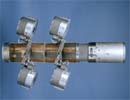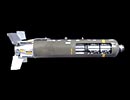US offers advanced smart missiles systems, Sensor Fuzed Weapons, to India
06 Oct 2008
 Washington: The Pentagon's Defence Security Cooperation Agency (DSCA) has notified the US Congress of its intention to sell India CBU-105 Sensor Fuzed Weapons (SFW), in a deal potentially worth $375 million, to help the "Indian Air Force to develop and enhance standardisation and operational ability with the United States".
Washington: The Pentagon's Defence Security Cooperation Agency (DSCA) has notified the US Congress of its intention to sell India CBU-105 Sensor Fuzed Weapons (SFW), in a deal potentially worth $375 million, to help the "Indian Air Force to develop and enhance standardisation and operational ability with the United States".
 India, the DSCA said, "has requested a possible sale of 510 CBU-105 Sensor Fuzed Weapons, 19 CBU-105 Integration test assets (12 live tails, seven inert tails) and five CBU-97 Integration test assets as well as associated equipment and services". The total value, if all options are exercised, could be as high as $375 million.
India, the DSCA said, "has requested a possible sale of 510 CBU-105 Sensor Fuzed Weapons, 19 CBU-105 Integration test assets (12 live tails, seven inert tails) and five CBU-97 Integration test assets as well as associated equipment and services". The total value, if all options are exercised, could be as high as $375 million.
 New Delhi, the agency said, has requested offsets for the deal, but at this time agreements are undetermined and will be defined in negotiations between India and the contractor.
New Delhi, the agency said, has requested offsets for the deal, but at this time agreements are undetermined and will be defined in negotiations between India and the contractor.
The prime contractor will be Textron Systems Corporation of Wilmington, Massachusetts.
"This proposed sale will contribute to the foreign policy and national security of the United States by helping to strengthen the US-India strategic relationship," the DSCA informed the US Congress on 30 September. This, incidentally, was just a day before the US Senate approved the India-US civil nuclear deal.
It will also help "improve the security of an important partner, which continues to be an important force for political stability, peace and economic progress in South Asia," the agency said, assuring lawmakers "the proposed sale of this equipment and support will not alter the basic military balance in the region".
The proposal comes just three weeks after the DSCA proposed the sale of two dozen Harpoon air-to-ground anti-ship missiles during Defence minister AK Antony's visit to Washington. This deal is potentially worth $170 million to prime contractor, Boeing.
"India intends to use the Sensor Fuzed Weapons to modernise its armed forces and enhance its defensive ability to counter ground-armoured threats.
"The missiles will assist the Indian Air Force to develop and enhance standardisation and operational ability with the United States. India will have no difficulty absorbing these missiles into its armed forces," the DSCA said.
"There will be no adverse impact on US defence readiness as a result of this proposed sale," it added.
The Sensor Fuzed Weapon
The SFW is a 1,000-pound class weapon designed to accurately detect and defeat a wide range of moving and stationary land and maritime target threats with minimal collateral damage, even as it succeeds in not leaving behind a single hazardous dud.
Textron Defence Systems describes its SFW as "the first and only combat-proven, clean battlefield weapon of its kind in US Air Force inventory".
The SFW contains 10 BLU-108 submunitions, each with four smart Skeet warheads, for a total of 40 warheads. One SFW can simultaneously detect and engage many fixed and moving land combat targets within 121,400 sq mts (30 acres).
This wide-area capability enables the SFW to halt an invading force and attack air defence sites while significantly reducing the number of aircraft sorties, it says.
Designed for stand-off deployment from a wide selection of aircraft, SFW's versatility and superior lethality make it the weapon of choice for anti-armour, destruction of enemy air defence and many other combat missions.
SFW can be deployed from tactical aircraft in all weather conditions, day or night, and is presently certified on most US Air Force fighter and bomber aircraft.
Each smart Skeet warhead can defeat a variety of moving and stationary targets, from heavy armoured battle tanks, soft-skinned vehicles to maritime threats. Many of these include parked aircraft, mobile radars and jammers, air defence vehicles and support vehicles.
A combination of laser range finder and dual-band infrared seeker enables the sub-munitions to attack only those targets matching the characteristics of military vehicles, and if none is found, there are two separate self-destruct modes to assure the bomb-lets will not remain unexploded. A third mechanism disables the sub-munition when batteries lose power a few minutes after release, making it safe even if it is not destroyed.
A single Sensor Fuzed Weapon equipped with 40 skeet sub-munitions can reliably destroy an entire enemy air defense site. Using the older Combined Effects Munition to do the same job would require 16 cluster bombs carrying a total of 3,200 sub-munitions. And since the sub-munitions on the older bomb have a 6 per cent dud rate, 180 would remain scattered around the target site as unexploded munition. The dud rate for SFW is less than 1 per cent.













.jpg)






.jpg)









